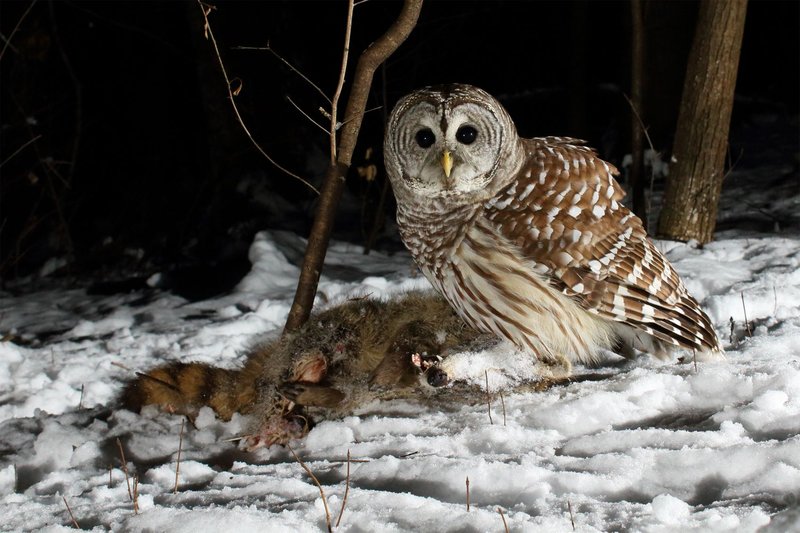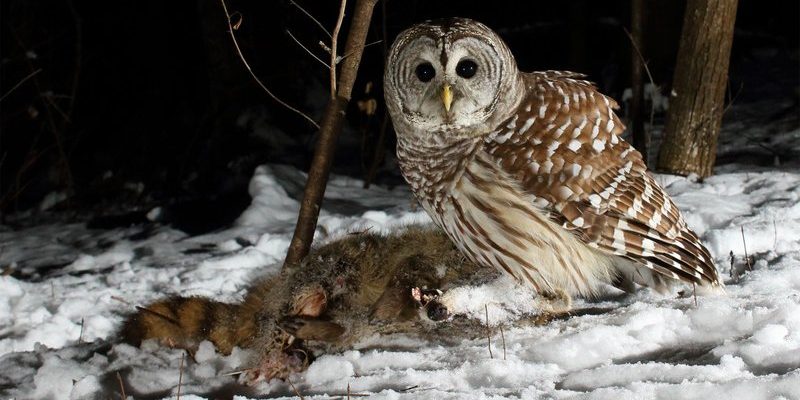
Owls are incredibly skilled predators, and their diets vary depending on their species and habitat. Some eat small mammals, while others prefer insects or even fish. The way they hunt is as unique as their diets. Their hunting techniques are a blend of skill, patience, and some serious talent for silent flight. Let’s dive deeper into the world of owls, exploring what they eat and how they catch their prey.
Owl Diet: What Do Owls Eat?
Owls are carnivorous birds, meaning they primarily eat meat. What they feast on can change quite a bit based on where they live. Here’s a quick overview of what different owls typically eat:
- Small Mammals: Most owls love munching on rodents like mice and voles. These critters provide a good amount of protein and energy.
- Birds: Some owls don’t mind a little competition and will catch smaller birds when the opportunity strikes.
- Insects: Especially smaller owls, like the Eastern Screech Owl, often hunt for crickets and beetles.
- Fish: Certain owl species, like the Great Horned Owl, have been known to catch fish. They’ll often do this near water bodies.
- Reptiles: Occasionally, owls might snack on small snakes or lizards.
Here’s the thing: an owl’s diet is not just about filling their bellies; it’s about survival. They have unique adaptations that help them thrive on whatever food is available. For instance, the Barn Owl has specialized facial features that help it detect even the tiniest sounds, making it easier to find prey hidden in dense grass.
How Owls Hunt: The Art of Stealth
When it comes to hunting, owls are masters of stealth. You might be wondering how they can sneak up on their prey without being noticed. Well, one of their secrets lies in their silent flight. Owls have specialized feathers that break up the turbulence as they fly, allowing them to glide through the air without making a sound. It’s like they have a built-in stealth mode.
Let me explain further. Imagine you’re trying to sneak up on someone without them hearing you; you’d want to be quiet, right? Owls do the same! They approach their prey slowly, often from a high perch, and when they’re ready, they swoop down with impressive precision. Their sharp talons are like nature’s version of a hunting tool, designed to latch onto their dinner.
One fascinating fact is how they capture their prey. Owls have incredibly strong feet, and when they dive, they can clamp down with a force powerful enough to pierce through fur or feathers. This helps them secure their meal quickly before it has a chance to escape.
Night Hunting: Owls and Their Vision
Unlike most birds, owls are primarily nocturnal, meaning they do most of their hunting at night. What helps them out? Their incredible night vision! Owls have large eyes that can absorb more light compared to those of other birds. This makes it much easier for them to see in the dark.
You might think about how hard it is for you to see at night. Imagine if you had built-in night goggles! That’s what the owls have, but it’s all thanks to their unique eye structure. Their eyes are also forward-facing, which gives them excellent depth perception. This helps them judge distances accurately when swooping down on their prey.
In addition to their great sight, owls have an acute sense of hearing. Some owls can even detect sounds from directions that might be impossible for other animals. This combination of great vision and hearing makes them formidable hunters in the dark.
Foraging Techniques: More Than Just Hunting
While hunting is a primary way owls get their food, they also engage in foraging techniques that help them find meals. For example, my favorite foraging method involves the owl using its keen hearing to listen for rustling in the leaves or the subtle movements of small creatures in the grass.
You might imagine an owl sitting still for hours, just listening intently, and you’d be right! Their patience pays off, as they can detect movement from quite a distance. This ability is particularly useful during times when they might not be actively hunting, like during the day.
Another method owls use involves searching for food remnants from other predators. Sometimes, an owl will scavenge, picking up leftovers from other animal hunts. It’s a smart way to make the most of any available resources. The more versatile an owl is in its approach, the better its chances of survival.
The Role of Habitat in Owl Diets
Owls are found in a variety of habitats, from forests to grasslands to deserts. The type of habitat an owl lives in plays a crucial role in determining its diet. For instance, a Barn Owl that lives in open fields will have a diet rich in rodents, while a Great Horned Owl living in a forest may have a broader menu, including birds and even rabbits.
Here’s the thing: Habitat affects not just what owls eat, but also how they hunt. In dense forests, for example, their hunting techniques might differ significantly from those in open areas. In thick foliage, they might rely more on their hearing and stealth to catch prey rather than the bold swoops they might use in open fields.
Additionally, seasonal changes can also impact what owls eat. During winter, when food is scarce, some owls may migrate or adjust their hunting strategies to survive. Such adaptability is one of the many reasons owls have thrived across diverse environments.
Owls are more than just symbols of wisdom; they’re remarkable hunters with unique adaptations that allow them to thrive in various environments. By understanding what they eat and how they hunt or forage, we gain insight into their lives and the roles they play in their ecosystems.
From their incredible night vision to their stealthy hunting tactics, owls reveal the wonders of nature. Next time you hear an owl hooting in the night, remember that it’s not just a call—it’s a reminder of the skill and tenacity that these creatures have. So, whether they’re perched silently or swooping down for a snack, owls remind us that there’s always more to discover in the natural world.

